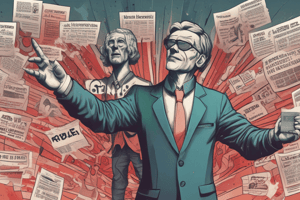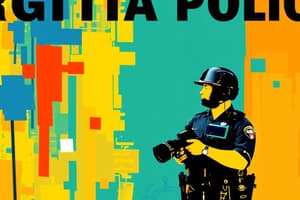Podcast
Questions and Answers
What does digital policy literacy involve?
What does digital policy literacy involve?
- Learning about online advertising techniques
- Becoming proficient in coding for the internet
- Understanding financial policies related to technology
- Knowledge of digital policy issues and informed consumption of information (correct)
Which statement accurately distinguishes social media from other online services?
Which statement accurately distinguishes social media from other online services?
- Social media is based solely on user-generated content and interactions.
- Social media must allow users to create profiles and engage with both content and other users. (correct)
- Social media exclusively allows for video sharing.
- Social media can only be accessed through dedicated applications.
What layer of the internet is concerned with the physical devices and connections?
What layer of the internet is concerned with the physical devices and connections?
- Physical layer (correct)
- Content layer
- Application layer
- Logical layer
In the context of the internet's layer model, what role does the application layer play?
In the context of the internet's layer model, what role does the application layer play?
Which of the following best describes Internet Service Providers (ISPs)?
Which of the following best describes Internet Service Providers (ISPs)?
How does user-generated content (UGC) fit into the content layer of the internet?
How does user-generated content (UGC) fit into the content layer of the internet?
What is a key characteristic of social media platforms like Instagram and TikTok?
What is a key characteristic of social media platforms like Instagram and TikTok?
What challenge arises when defining social media?
What challenge arises when defining social media?
Which of the following best describes 'data retention'?
Which of the following best describes 'data retention'?
What does the term 'veracity' in the context of Big Data refer to?
What does the term 'veracity' in the context of Big Data refer to?
What are the three types of analytics mentioned in the content?
What are the three types of analytics mentioned in the content?
Which of the following statements about Big Data is NOT accurate?
Which of the following statements about Big Data is NOT accurate?
What is meant by 'metadata'?
What is meant by 'metadata'?
Which of the following captures the essence of 'digital dossier'?
Which of the following captures the essence of 'digital dossier'?
What does the 'volume' characteristic of Big Data represent?
What does the 'volume' characteristic of Big Data represent?
Which concept emphasizes the ethical concerns related to data accessibility?
Which concept emphasizes the ethical concerns related to data accessibility?
What is the primary function of ITP in internet communication?
What is the primary function of ITP in internet communication?
Which of the following best describes packet-switched communication?
Which of the following best describes packet-switched communication?
What is boomerang routing?
What is boomerang routing?
What does network sovereignty refer to?
What does network sovereignty refer to?
What is the goal of data localization?
What is the goal of data localization?
How does artificial intelligence influence decision-making?
How does artificial intelligence influence decision-making?
Which of the following statements correctly characterizes big data?
Which of the following statements correctly characterizes big data?
What ethical concerns are raised by the collection of big data and AI?
What ethical concerns are raised by the collection of big data and AI?
What does prescriptive data analysis aim to determine?
What does prescriptive data analysis aim to determine?
What is a significant issue when it comes to eligibility determinations and big data?
What is a significant issue when it comes to eligibility determinations and big data?
Which factor contributes to the bias present in big data analysis?
Which factor contributes to the bias present in big data analysis?
What characterizes a 'mobile-only' user?
What characterizes a 'mobile-only' user?
What contributes to the digital divide related to mobile internet access?
What contributes to the digital divide related to mobile internet access?
How do mobile devices generally compare to PCs in terms of capabilities?
How do mobile devices generally compare to PCs in terms of capabilities?
What does the term 'embodied computing' refer to?
What does the term 'embodied computing' refer to?
Which statement about mobile internet is false?
Which statement about mobile internet is false?
What is a significant reason that people do not read terms of service and privacy policies?
What is a significant reason that people do not read terms of service and privacy policies?
Which of the following accurately describes clickwrap agreements?
Which of the following accurately describes clickwrap agreements?
What is meant by 'commons-based peer production'?
What is meant by 'commons-based peer production'?
Which of the following is considered an example of digital commons?
Which of the following is considered an example of digital commons?
In the context of the networked information economy, what does 'removing barriers to entry' imply?
In the context of the networked information economy, what does 'removing barriers to entry' imply?
What does the term 'intellectual property' refer to?
What does the term 'intellectual property' refer to?
What is a consequence of the clickwrap agreement design?
What is a consequence of the clickwrap agreement design?
Which statement is true about the relationship between users and their data?
Which statement is true about the relationship between users and their data?
What characterizes the open source concept?
What characterizes the open source concept?
What is one of the intrinsic motivations for individuals participating in open source projects?
What is one of the intrinsic motivations for individuals participating in open source projects?
Which of the following statements about Creative Commons licenses is true?
Which of the following statements about Creative Commons licenses is true?
What does open access primarily aim to provide?
What does open access primarily aim to provide?
Which of the following correctly defines misinformation?
Which of the following correctly defines misinformation?
What is a significant feature of Wikipedia?
What is a significant feature of Wikipedia?
Which motivation is considered extrinsic in the context of open source projects?
Which motivation is considered extrinsic in the context of open source projects?
Which statement reflects the ideology behind open source?
Which statement reflects the ideology behind open source?
Flashcards
Digital Policy Literacy
Digital Policy Literacy
The knowledge about digital policy issues, allowing informed online consumption.
Internet Enthusiast vs. Skeptic
Internet Enthusiast vs. Skeptic
Different perspectives on the internet's impact, its use, and its risks.
Social Media
Social Media
Web 2.0-based services allowing user-generated content sharing and interaction.
Social Media Definition (Problem)
Social Media Definition (Problem)
Signup and view all the flashcards
Internet Layer Model
Internet Layer Model
Signup and view all the flashcards
Internet Service Provider (ISP)
Internet Service Provider (ISP)
Signup and view all the flashcards
Internet Layer (Application)
Internet Layer (Application)
Signup and view all the flashcards
Internet
Internet
Signup and view all the flashcards
ITP (Internet Transit Provider)
ITP (Internet Transit Provider)
Signup and view all the flashcards
Packet-switched communication
Packet-switched communication
Signup and view all the flashcards
Signals intelligence
Signals intelligence
Signup and view all the flashcards
Boomerang routing
Boomerang routing
Signup and view all the flashcards
Network sovereignty
Network sovereignty
Signup and view all the flashcards
Internet exchange point (IXP)
Internet exchange point (IXP)
Signup and view all the flashcards
Data localization
Data localization
Signup and view all the flashcards
Artificial intelligence (AI)
Artificial intelligence (AI)
Signup and view all the flashcards
Big Data Definition (Early)
Big Data Definition (Early)
Signup and view all the flashcards
Big Data Aspects
Big Data Aspects
Signup and view all the flashcards
Big Data's Four V's
Big Data's Four V's
Signup and view all the flashcards
Digital Dossier
Digital Dossier
Signup and view all the flashcards
Metadata
Metadata
Signup and view all the flashcards
Descriptive Analytics
Descriptive Analytics
Signup and view all the flashcards
Predictive Analytics
Predictive Analytics
Signup and view all the flashcards
Algorithm
Algorithm
Signup and view all the flashcards
Clickwrap
Clickwrap
Signup and view all the flashcards
Privacy policy neglect
Privacy policy neglect
Signup and view all the flashcards
Commons-based peer production
Commons-based peer production
Signup and view all the flashcards
Digital commons
Digital commons
Signup and view all the flashcards
Intellectual property
Intellectual property
Signup and view all the flashcards
Notice policy
Notice policy
Signup and view all the flashcards
Legalese (policies)
Legalese (policies)
Signup and view all the flashcards
Networked information economy
Networked information economy
Signup and view all the flashcards
Prescriptive Analytics
Prescriptive Analytics
Signup and view all the flashcards
Scored Society (Pasquale)
Scored Society (Pasquale)
Signup and view all the flashcards
Eligibility Determinations
Eligibility Determinations
Signup and view all the flashcards
Biased Datasets
Biased Datasets
Signup and view all the flashcards
Mobile Internet Underclass
Mobile Internet Underclass
Signup and view all the flashcards
Embodied Computing
Embodied Computing
Signup and view all the flashcards
Mobile-Only/Mostly Internet
Mobile-Only/Mostly Internet
Signup and view all the flashcards
Mobile Internet vs. Broadband
Mobile Internet vs. Broadband
Signup and view all the flashcards
Open Source
Open Source
Signup and view all the flashcards
Open Access
Open Access
Signup and view all the flashcards
Copyright
Copyright
Signup and view all the flashcards
Creative Commons License
Creative Commons License
Signup and view all the flashcards
Misinformation
Misinformation
Signup and view all the flashcards
Intrinsic Motivation
Intrinsic Motivation
Signup and view all the flashcards
Extrinsic Motivation
Extrinsic Motivation
Signup and view all the flashcards
Wikipedia
Wikipedia
Signup and view all the flashcards
Study Notes
CMDS 2500: Final Test Review Guide
- Internet Enthusiast vs. Skeptic: Digital policy literacy is crucial for informed online consumption. Are we blindly consuming online information or understanding its context? This involves understanding online privacy, digital divides, and IP protections.
Social Media
- Definition: User-generated content (UGC), web 2.0 technologies, and user interaction via profiles. A distinction exists between standalone and built-in functionalities. Examples of standalone platforms are Instagram, TikTok, and YouTube; while news services like CBC may incorporate social media functionalities.
Internet
-
Definition: A global network of devices (computers, phones, IoT devices). This is described by a layer model.
- Physical Layer: The physical network components.
- Logical Layer: The language (internet protocols) enabling transmissions.
- Application Layer: The software/apps used to connect with the internet.
- Content Layer: The content accessed through devices and applications.
Big Data
- Concept: Extremely large datasets. The definition of "large" is constantly evolving due to the normalized increase in data.
- Definition: Initially, it was datasets requiring supercomputers to process. Now, home computers can process some types.
- Four V's of Big Data:
- Volume: The scale of data.
- Variety: Data from multiple sources.
- Velocity: Speed of data analysis.
- Veracity: Accuracy/uncertainty of the data.
Artificial Intelligence (AI)
- Definition: Technology simulating human learning, comprehension, problem-solving, and decision-making in machines.
- Data Collection and Analytics: There's an impact related to the use of AI in data collection, analysis, and the implications for users.
Mobile Devices and Internet
- Mobile Devices: Computers that are usable when mobile (e.g., smartphones, tablets).
- Mobile Internet: A limited version of the desktop internet, based on cellular networks; it's significantly more limited. Distinguishing between mobile-only, mobile-mostly users.
- Mobile Internet Underclass: Users confined to mobile internet access have an inferior browsing experience, creating a digital divide.
Privacy and Data
- Embodied Computing: Devices integrated into our bodies (wearables, digestibles), and their relationship to privacy and data collection.
- Definitions of Privacy: Definitions are complex (e.g., the ability to opt out, freedom from observation in one's home).
- Nothing to Hide Argument: The argument that data collection is acceptable because users have nothing to hide.
Open Source and Public Information
- Wikipedia: Example of open-source collaborative online knowledge production.
- Open Access/Open Materials: Communal ownership of technologies and access to data.
- Intellectual Property (IP): Legal rights to creations of the mind(e.g., artistic works, design).
- Open Source Concept and Motivations: A model where design access is encouraged.
- Intrinsic Motivations: Desires to advance shared ideals.
- Extrinsic Motivations: Personal development/career goals.
- Copyright: Legal rights to reproduce/reproduce a work. Usage of Creative Commons licenses to create various licenses related to copyright.
- Information Literacy Skills and knowledge in evaluating, using, and filtering information.
Other Concepts
- Misinformation/Disinformation: Information that is inaccurate or intended to deceive; distinction between the two.
- Civic Online Reasoning: Skillset in evaluating and verifying online information, especially political.
- Notice Policies and clickwrap: The methods of presenting terms of service and privacy policies (often long, dense, and not well read); the idea that people agree to policies by clicking a button.
Studying That Suits You
Use AI to generate personalized quizzes and flashcards to suit your learning preferences.




